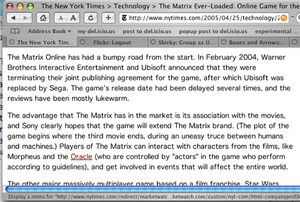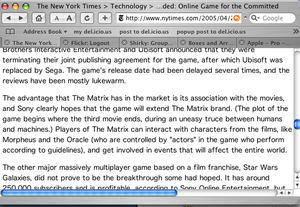NYTimes.com Redesign Includes Tag Clouds
Though you may not have noticed it at first (I didn’t – they’re located a few steps off the front page), the recently launched design of NYTimes.com includes tag clouds. After a quick review, I think their version is a good example of a cloud that offers some increased capabilities and contextual information that together fall in line with the likely directions of tag cloud evolution we’ve considered before.
Specifically, the New York Times tag cloud:
NYtimes.com Tag Cloud

The NYTimes.com tag cloud shows the most popular search terms used by readers within three time frames: the last 24 hours, the last 7 days, and the last 30 days. Choosing search terms as the makeup for a cloud is a bit curious – but it may be as close to socially generated metadata as seemed reasonable for a first exploration (one that doesn’t require a substantial change in the business or publishing model).
Given the way that clouds lend themselves to showing multiple dimensions of meaning, such as change over time, I think the Times tag cloud would be more valuable if it offered the option to see all three time frames at once. I put together a quick cut and paste of a concept screen that shows this sort of layout:
Screen Concept: 3 Clouds for Different Time Frames

In an example of the rapid morphing of memes and definitions to fit shifting usage contexts (as in Thomas Vanderwal’s observations on the shifting usage of folksonomy) the NYTimes.com kept the label tag cloud, while this is more properly a weighted list: the tags shown are in fact search terms, and not labels applied to a focus of some kind by taggers.
It’s plain from the limited presence and visibility of clouds within the overall site that the staff at NYTimes.com are still exploring the value of tag clouds for their specific needs (which I think is a mature approach), otherwise I imagine the new design concept and navigation model would utilize and emphasized tag clouds to a greater degree. So far, the Times uses tag clouds only in the new “Most Popular” section, and they are offered as an alternative to the default list style presentation of popular search terms. This position within the site structure places them a few steps in, and off the standard front page-to-an-article user flow that must be one of the core scenarios supported by the site’s information architecture.
NYTimes.com User Flow to Tag Cloud

Still, I do think it’s a clear sign of increasing awareness of the potential strength of tag clouds as a way of visualizing semantic information. The Times is an established entity (occasionally serving as the definition of ‘the establishment’), and so is less likely to endanger established relationships with customers by changing its core product across any of the many channels used for delivery.
Questions of risk aside, tag clouds (here I mean any visualization of semantic metadata) couLd be a very effective way to scan the headlines for a sense of what’s happening at the moment, and the shifting importance of topics in relation to on another. With a tag cloud highlighting “immigration”, “duke”, and “judas”, visitors can immediately begin to understand what is newsworthy – at least in the minds of NYTimes.com readers.
At first glance, lowering the amount of time spent reading the news could seem like a strong business disincentive for using tag clouds to streamline navigation and user flow. With more consideration, I think it points to a new potential application of tag clouds to enhance comprehension and findability by giving busy customers powerful tools to increase the speed and quality of their judgments about what to devote their attention to in order to acheive understanding greater depth. In the case of publications like the NYTimes.com, tag clouds may be well suited for conveying snapshots or summaries of complex and deep domains that change quickly (what’s the news?), and offering rapid navigation to specific areas or topics.
A new user experience that offers a variety of tag clouds in more places might allow different kinds of movement or flow through the larger environment, enabling new behaviors and supporting differing goals than the current information architecture and user experience.
Possible Screen Flow Incorporating Clouds

Stepping back from the specifics of the design, a broader question is “Why tag clouds now?” They’re certainly timely, but that’s not a business model. This is just speculation, but I recall job postings for an Information Architect position within the NYTimes.com group on that appeared on several recruiting websites a few months ago – maybe the new team members wanted or were directed to include tag clouds in this design? If any of those involved are allowed to share insights, I’d very much like to hear the thoughts of the IAs / designers / product managers or other team members responsible for including tag clouds in the new design and structure.
And in light of Mathew Patterson’s comments here about customer acceptance of multiple clouds in other settings and contexts (priceline europe), I’m curious about any usability testing or other user research that might have been done around the new design, and any the findings related to tag clouds.

